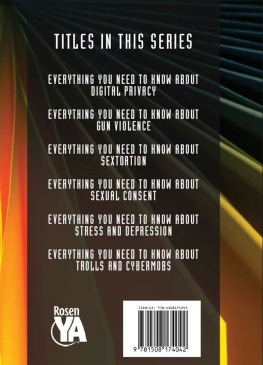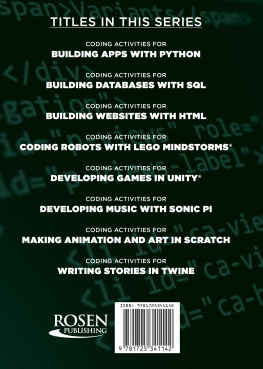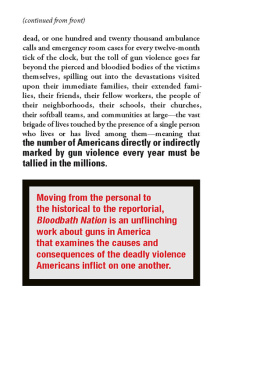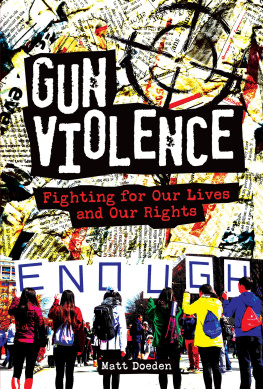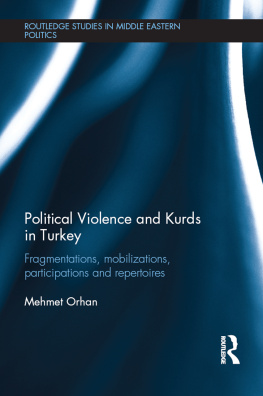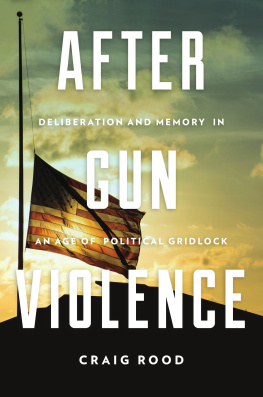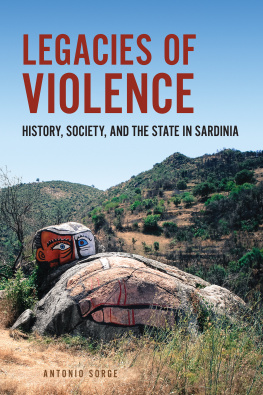Published in 2018 by The Rosen Publishing Group, Inc.
29 East 21st Street, New York, NY 10010
Copyright 2018 by The Rosen Publishing Group, Inc.
First Edition
All rights reserved. No part of this book may be reproduced in any form without permission in writing from the publisher, except by a reviewer.
Library of Congress Cataloging-in-Publication Data
Names: Furgang, Adam, author.
Title: Everything you need to know about gun violence / Adam Furgang.
Description: New York : Rosen Publishing, 2018. | Series: The need to know library | Audience: Grades 7-12. | Includes bibliographical references and index.
Identifiers: LCCN 2017002120 | ISBN 9781508174042 (library-bound) | ISBN 9781508174028 (pbk.) | ISBN 9781508174035 (6-pack)
Subjects: LCSH: Gun controlUnited StatesJuvenile literature. | Firearms ownershipUnited StatesJuvenile literature. | Violent crimesUnited StatesJuvenile literature.
Classification: LCC HV7436 .F87 2018 | DDC 363.330973dc23
LC record available at https://lccn.loc.gov/2017002120
Manufactured in the United States of America
CONTENTS
INTRODUCTION
CHAPTER ONE
THE SECOND AMENDMENT AND GUN HISTORY
CHAPTER TWO
GUN VIOLENCE TODAY
CHAPTER THREE
HOW DOES THE UNITED STATES COMPARE TO OTHER COUNTRIES?
CHAPTER FOUR
EXPLORING THE ISSUES
CHAPTER FIVE
WHAT CAN I DO ABOUT GUN VIOLENCE?
GLOSSARY
FOR MORE INFORMATION
FOR FURTHER READING
BIBLIOGRAPHY
INDEX
INTRODUCTION
I f you watch the news, it might seem like there is new evidence of gun violence every day. It might also seem like the problem is worsening. But if you look at statistics gathered by the Centers for Disease Control and Prevention, gun violence overall in the United States has been dropping steadily since the 1990s. In 1993, firearms killed 7 out of every 100,000 Americans. But by 2013, that number changed to only about 3.6 out of every 100,000 Americans. Nonfatal crimes with firearms also declined during the same time period.
There are a couple of reasons why we hear about gun violence so much on the news. One is that more Americans are paying attention to gun violence. In fact, the issue has become one that polarizes, or divides, people. Some want more laws to restrict the use of guns, in hopes of cutting down on violence and death. Others feel that restricting peoples access to guns would go against the Constitution of the United States.
Another reason for the proliferation of incidences of gun violence in the news is simply that it is a problem that still eludes a solution. In 2014 alone, according to CNN, more than 30,000 Americans died from gun violence. The phenomenon of mass shootings, attacks on four or more people, in particular, have created anxiety that a large number of people at a time can become vulnerable to gun violence. In 2015, there were 294 mass shootings in the United States in 274 days. The effects of mass shootings are vast and troublesome no matter where they occur.
President Barack Obama discusses the epidemic of gun violence in America with CNNs Anderson Cooper.
In addition to mass shootings, gun violence can manifest itself in other ways. Gangs in urban, rural, and suburban areas rely on guns and may use them against rivals. Robberies often involve guns. Individual disputes, from property disputes to domestic issues, sometimes end with the use of guns. Suicide is another tragic example of the use of guns. Although guns are not the most common method for suicide attempts, they are the most successful. According to Harvard Public Health magazine, 85 percent of people who attempt suicide with a gun end up dying. That compares starkly to other methods, such as attempted drug overdoses, which are just 3 percent lethal. The damage of a gun is massive and irreversible.
Its important for young people to understand the effects of gun violence on our culture. Even though there are different sides to this controversial issue, its important for people on both sides of the issue to understand as much as possible about it. Its only then that young people can make informed decisions about what the future of gun violence and gun control will look like. Guns in the United States have followed a certain trajectory in history, spotted with laws that follow (or failed to manifest) on the heels of gun violence in America, and movements that passionately fight for or against what guns do and represent. But the American model of gun legislation isnt the only example, so it is useful to compare gun control in the US to that in other countries. One last important point to discuss is how young people can engage in a knowing way with the possibilities of influencing legislation or encountering handling guns or delicate situations with great potential to end badly.
CHAPTER ONE
THE SECOND AMENDMENT AND GUN HISTORY
W hen Americans think about the future of gun control and how gun violence will affect the nation, it is important to think about the history of guns as well. The story of how guns have shaped our nation and its laws are a great limit to how much change is possible in the direction of restricting or enabling gun users.
THE BEGINNING OF THE RIGHT TO BEAR ARMS
When the Constitution was written, the Founding Fathers hoped to set down a list of basic rights and laws for all American citizens. The original document, signed in 1787, focused much on the basic rights of life, liberty, and the pursuit of happiness. The writers purposely left room for the document to be changed, through the passing of amendments, or additions. The first ten amendments are called the Bill of Rights. They named specific rights that Americans are entitled to and that state and local laws should respect when they write their own laws.
The Second Amendment involves gun control and the right to own and carry firearms. Congress passed the Second Amendment on September 25, 1789, and it was ratified, or made legal and official, on December 15, 1791. The amendment states, A well regulated Militia, being necessary to the security of a free State, the right of the people to keep and bear Arms, shall not be infringed.
The wording of the amendment hints at the history of the country and how it was formed. A militia is a military presence that comes from the civilian population. It is often used to help a regular army when needed, such as in the case of an emergency or attack. In some cases, a militia may be all that is available to fight against oppressors such as other armies and governments. The founders thought that if citizens were kept from being able to form a militia, the countrys freedom could be at risk. Militias often supply their own weapons, so the right of an average citizen to keep firearms was very important.
As the nation grew and changed, the right to bear arms became important for frontiersmen and farmers. The right to bear arms allowed them to protect themselves, their families, and their property from the attack of hostile Native Americans or outlaws. It helped them to hunt and feed their families, and to infiltrate land in the west that they hadnt yet taken over and annexed.

